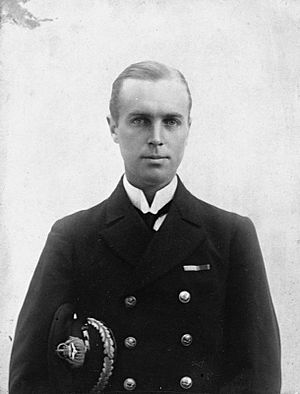Richard Bell Davies facts for kids
Quick facts for kids
Richard Bell Davies
|
|
|---|---|

Richard Bell Davies during the First World War, c. 1916–18
|
|
| Born | 19 May 1886 Kensington, London |
| Died | 26 February 1966 (aged 79) RNH Haslar, Portsmouth |
| Allegiance | United Kingdom |
| Service/ |
Royal Navy |
| Years of service | 1901–1944 |
| Rank | Vice Admiral |
| Commands held | HMS Pretoria Castle (1943–44) HMS Dasher (1942) Rear Admiral, Naval Air Stations (1939–41) HMS Cornwall (1933–35) HMS London (1929–30) No. 3 Squadron RNAS (1915) |
| Battles/wars | First World War Second World War |
| Awards | Victoria Cross Companion of the Order of the Bath Distinguished Service Order Air Force Cross Mentioned in Despatches Knight of the Legion of Honour (France) Croix de guerre (France) Order of Michael the Brave (Rumania) |
Vice Admiral Richard Bell Davies VC, CB, DSO, AFC (May 19, 1886 – February 26, 1966) was a brave British naval officer and pilot. He is famous for being awarded the Victoria Cross, which is the highest award for bravery given to military personnel in the United Kingdom and Commonwealth countries. He was a Vice Admiral in the Royal Navy and served in both the First World War and Second World War.
Contents
Richard Bell Davies was born in Kensington, London. Sadly, he became an orphan by the age of five and was raised by his uncle, who was a doctor. He went to Bradfield College from 1899 to 1901.
In 1901, Davies joined the Royal Navy. He started his training on HMS Britannia. By 1902, he was a naval cadet on the ship HMS Diana (1895) (HMS Diana), which was part of the Mediterranean Fleet. In 1910, he learned to fly planes privately. By 1913, he joined the Royal Naval Air Service (RNAS) and became a squadron commander.
Heroic Actions in the First World War
Distinguished Service Order
At the beginning of the First World War, Davies and another pilot, Richard Peirse, flew many missions. They attacked German submarine bases in places like Ostend and Zeebrugge. For their bravery, both pilots received the Distinguished Service Order (DSO).
On January 23, 1915, they attacked submarines at Zeebrugge. They flew very close to the ground, even though they faced heavy enemy fire. During this attack, Davies was badly wounded in his leg by a bullet. Despite the pain and bleeding, he kept flying his plane skillfully for an hour to finish his mission.
Victoria Cross for a Daring Rescue
Davies was later sent to the Gallipoli campaign. He earned the Victoria Cross on January 1, 1916, for an amazing act of bravery on November 19, 1915. This happened near Ferrijik Junction, which was then in Bulgaria.
Davies was 29 years old and in charge of No. 3 Squadron RNAS. During a bombing attack, another pilot, Flight Sub-Lieutenant Gilbert Formby Smylie, was shot down. Smylie's plane crashed into a marsh. He quickly set his plane on fire to destroy it and prevent the enemy from getting it.
Davies saw Smylie's plane go down. He decided to land his own plane to rescue Smylie. This was a very risky move because enemy soldiers were nearby. Davies landed safely, picked up Smylie, and flew back to the aerodrome. This was the first time in history that an aircraft performed a combat search and rescue mission.
Davies' plane, a Nieuport 10, was a single-seat model. It had a small covered area in the front. When Davies rescued Smylie, Smylie had to squeeze past Davies and through the controls into this tiny front space. He was so tightly wedged that it took two hours to get him out after they landed!
For his service in Gallipoli, Davies was also mentioned in official reports for his bravery.
In 1916, Davies moved to the Western Front. He flew bombing raids behind German lines. Later, he became a wing commander on the seaplane carrier HMS Campania. When the RNAS joined the Royal Air Force in 1918, he stayed with the Royal Navy. At the end of the war, he received the Air Force Cross and the French Croix de guerre.
Between the Wars and Second World War
After the First World War, Davies continued his career in the Royal Navy. From 1919 to 1920, he was the first lieutenant of HMS Lion. He then worked in the Naval Staff's Air Section from 1920 to 1924.
He was promoted to captain in 1926. He commanded HMS Cornwall in China from 1933 to 1935. He also commanded the naval base at Devonport from 1936 to 1938. In 1938, he became a rear admiral. From 1939 to 1941, he was in charge of Naval Air Stations. He was also honored as a Companion of the Order of the Bath in 1939.
Davies retired as a vice admiral in 1941, at age 55. However, he then joined the Royal Naval Reserve (RNR) as a commander. During the Second World War, he led convoys of ships. He also served as the captain of the escort carrier HMS Dasher and the trials carrier HMS Pretoria Castle. He left the RNR in 1944.
Later Life and Legacy
Richard Bell Davies passed away in Gosport, Hampshire. His Victoria Cross medal is now on display at the Fleet Air Arm Museum in Yeovil, Somerset.
On November 19, 2015, a special memorial service was held for him in London. A memorial stone was placed in Sloane Square, Chelsea, to remember his incredible bravery.
See also

